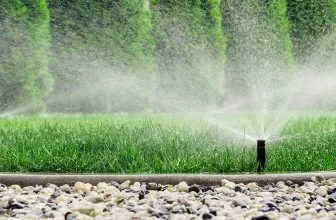Best Walkway Ideas For Your Front Or Backyard
Whether you are planning on selling your home or you just want to upgrade the exterior landscaping concepts of your property, curb appeal matters. Retaining walls, rock gardens, fire pits, outdoor art, and water features are all great ways to spruce up your property. Though one of the less appreciated, yet very effective ways to make an impact on your yard is to install a tasteful walkway.
In the past, sidewalks and patio paver stones were the most functional ways to create a walkway. Yet they still got a reputation for being a little too plain and uninteresting.
In this article, we’ll take a closer look at some of the best walkway options to consider for upgrading your exterior landscaping concept. If anything a front or backyard walkway is a great way to keep your grass healthy while people make their way to your home or walking to other outdoor features.

The Best Walkway Options For The Front Yard
Your front yard is all about curb appeal. While keeping the lawn neatly manicured and free of debris is essential, a walkway creates a visual as well as functional flow. It’s also a great way to keep guests, delivery people, and door to door salesmen from walking on your lawn.
Stamped Concrete
The plain jane concrete sidewalk is hardly the sort of thing that will punch up your curb appeal. Thankfully, modern material improvements and engineering techniques have now made stamped concrete a very popular way to create a visually stunning walkway.
Contractors can add colorings to match or contrast the exterior appearance of your home. Stamped concrete can also be textured for better traction when wet. It’s especially handy if winter conditions in your area create a lot of slippery ice.

Stone Slab Pavers
These days slabs are available in natural as well as artificial stone. In the past, this limited you to bluestone or other slate-like shades. Which could sometimes be a little bit slippery when wet. Artificial stone slabs have become increasingly popular, and modern material manufacturing has helped lower the price.
Artificial stone slabs are available in a wide range of colors. You might even be able to source them in custom colors to perfectly match or accent your home’s exterior. Of course, artificial stone slabs can also be gently textured to give better traction when they are wet or icy.
When it comes to the seams between stone slabs, you can put them close together, much as you would sections of concrete sidewalk. Though you might also want to consider spacing the slabs an inch or two apart to line them with deep roles of pebbles or colored gravel. This gives you yet another area to play with some accent or contrasting colors. There are also pebbles that glow in the dark and recharge with sunlight that can further be used to accent the walkway seams at night.

Natural Flagstone Walkway
Flagstones are much beloved for their natural appearance and the fact that each walkway is unique. They tend to be just as welcome in the front or backyard. They tend to only be available in bluestone or slate colors. Though there might be some locally sourced rock available with its own tone.
The challenge with any flagstone walkway is fitting the slabs closely together. Since each is organic and unique in its own shape, you or the landscaping contractor might spend a lot of extra hours fitting the stones closely together.
The seams between flagstones are also something that needs to be considered. After the base layer has been tamped firmly into place, you’ll have to choose between concrete seams or using loose natural rocks like pea gravel, or colored pebbles.
Concrete seams are arguably a little plain, and some see them as outdated for a flagstone concept. However, they are much easier to remove snow from compared to loose rock or pebbles. Especially if you are going to be clearing winter snow with a snowblower, where a small rock could jam the impeller.

Popular Backyard Walkway Concepts
Sure, a backyard walkway doesn’t carry as much gravitas as the front yard’s “Curb Appeal” but that doesn’t mean it’s the place to cut corners. Especially, if you are adding walkways to improve your home’s resale value.

A Raised Boardwalk
The raised boardwalk concept isn’t exactly new, but it’s still enjoying a vigorous renaissance in backyard landscaping concepts. It’s especially popular in yards with mature exotic trees or a lawn with accenting water features and outdoor art on display. The directional nature of the boardwalk lets you control the visual and physical flow of your outdoor space.
The type of wood you use can greatly impact the price. So, boardwalks tend to be more common in small yards.
Cedar – This is one of the more popular materials for decks, boardwalks, and even picnic tables. It offers superior pest and rot resistance. Though you will need to sand it every year or two if you plan to walk on it barefoot, as it gradually becomes prone to splinters and minor cracks.
Cypress & Redwood – These two kinds of wood are too exotic and rare these days to be purchased new. However, they are supremely resistant to rot and insects, which has driven some contractors to reclaim older lumbers and recondition it for use.
Composite Wood – This is technically an artificial type of wood made from recycled hardwood saw dust and polymers. It’s increasing popularity in deck construction has also made it a great alternative for boardwalks. It’s available in several different shades, which makes it a great option for matching or contrasting your existing exterior concepts.

An Aggregate Stone Walkway
Aggregate stone used to be very popular in new construction homes in the 1980s and 90s. Today it is enjoying a rapid return to popularity. It’s essentially pea gravels that are held in suspension with a heavy-duty concrete. Different gravels can be used to affect the overall color and appearance. It’s a great way to blend a walkway with a rock garden or water feature.

Aggregate Recycled Rubber
This is a material that is constantly evolving. It takes finely ground rubber from things like outdated tires and blends it with a polymer to make a waterproof paving surface. Depending on where you live, you might be able to source it very cheaply. It also has a natural texture that keeps it from being slippery when wet or icy.
Rubber Pavers
This is in the same vein as the aggregate rubber. Except in the form of interlocking paving stones. There’s a little bit more refining in the process than you find with pourable aggregate recycled rubber, but it also has a softer feel when walking barefoot. You can also lay them outline tiles to create distinct visual lines.






